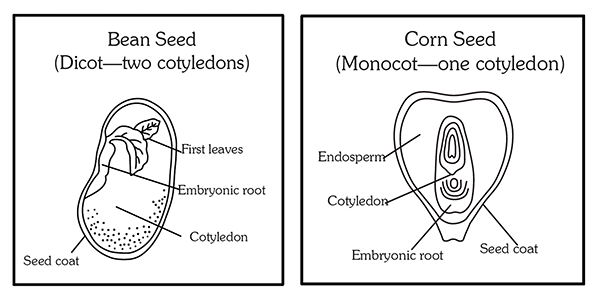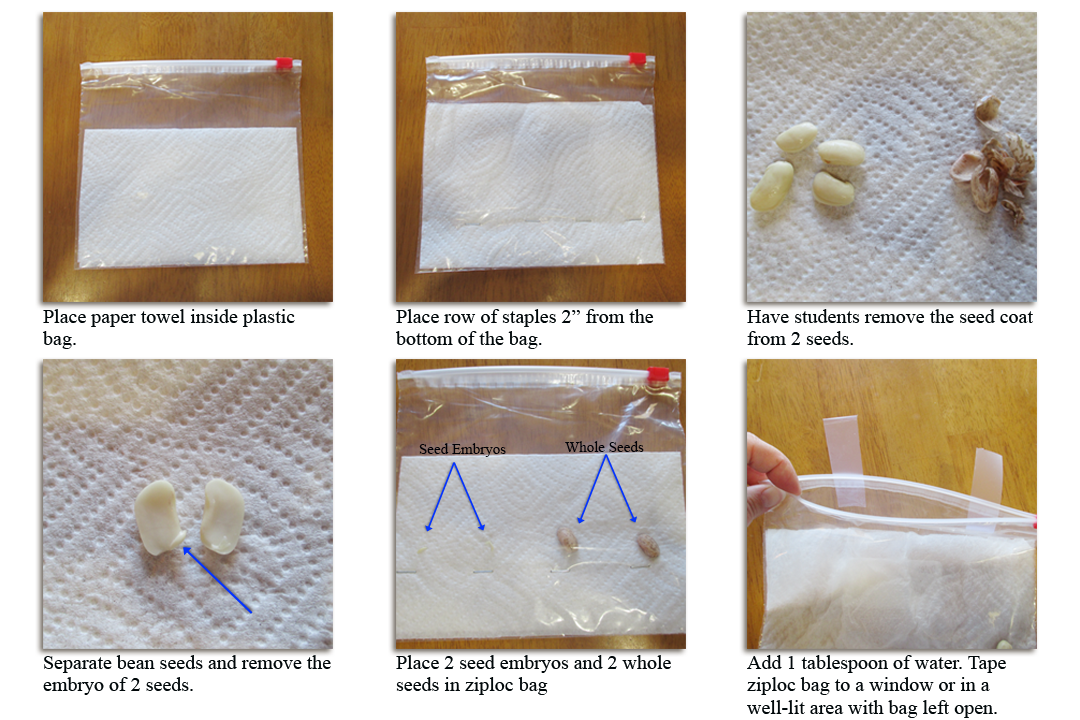Seeds, Miraculous Seeds
Students dissect seeds, identify the anatomy and function of seed parts, and classify seeds as monocots or dicots.
Background
Lesson Activities
Recommended Companion Resources
Credits
Author
Debra Spielmaker | Utah Agriculture in the Classroom
Standards
Texas Content Area Standards
-
ELA: 3.110.5.b.3
Developing and sustaining foundational language skills: listening, speaking, reading, writing, and thinking- vocabulary. The student uses newly acquired vocabulary expressively.
- ELA: 3.110.5.b.3.B: use context within and beyond a sentence to determine the meaning of unfamiliar words and multiple-meaning words;
-
ELA: 4.110.6.b.1
Developing and sustaining foundational language skills: listening, speaking, discussion, and thinking- oral language. The students develops oral language through listening, speaking, and discussion.
- ELA: 4.110.6.b.1.D: work collaboratively with others to develop a plan of shared responsibilities
-
ELA: 4.110.6.b.3
Developing and sustaining foundational language skills: listening, speaking, reading, writing, and thinking- vocabulary. The student uses newly acquired vocabulary expressively.
- ELA: 4.110.6.b.3.B: use context within and beyond a sentence to determine the relevant meaning of unfamiliar words or multiple-meaning words
-
ELA: 5.110.7.b.3
Developing and sustaining foundational language skills: listening, speaking, reading, writing, and thinking- vocabulary. The student uses newly acquired vocabulary expressively.
- ELA: 5.110.7.b.3.B: use context within and beyond a sentence to determine the relevant meaning of unfamiliar words or multiple-meaning words
-
Social Studies: 3.113.14.c.15
Social studies skills. The student communicates in written, oral, and visual forms. The student is expected to:
- Social Studies: 3.113.14.c.15.D: express ideas orally based on knowledge and experiences
-
Social Studies: 4.113.15.c.21
Social studies skills. The student communicates in written, oral, and visual forms. The student is expected to:
- Social Studies: 4.113.15.c.21.C: express ideas orally based on research and experiences
-
Social Studies: 5.113.16.c.25
Social studies skills. The student communicates in written, oral, and visual forms. The student is expected to:
- Social Studies: 5.113.16.c.25.C: express ideas orally based on research and experiences
-
Science: 3.112.5.b.1
Scientific and engineering practices. The student asks questions, identifies problems, and plans and safely conducts classroom, laboratory, and field investigations to answer questions, explain phenomena, or design solutions using appropriate tools and models. The student is expected to:
- Science: 3.112.5.b.1.B: use scientific practices to plan and conduct descriptive investigations and use engineering practices to design solutions to problems
- Science: 3.112.5.b.1.E: collect observations and measurements as evidence
- Science: 3.112.5.b.1.F: construct appropriate graphic organizers to collect data, including tables, bar graphs, line graphs, tree maps, concept maps, Venn diagrams, flow charts or sequence maps, and input-output tables that show cause and effect
-
Science: 3.112.5.b.5
Recurring themes and concepts. The student understands that recurring themes and concepts provide a framework for making connections across disciplines. The student is expected to:
- Science: 3.112.5.b.5.F: explain the relationship between the structure and function of objects, organisms, and systems
-
Science: 4.112.6.b.1
Scientific and engineering practices. The student asks questions, identifies problems, and plans and safely conducts classroom, laboratory, and field investigations to answer questions, explain phenomena, or design solutions using appropriate tools and models. The student is expected to:
- Science: 4.112.6.b.1.B: use scientific practices to plan and conduct descriptive investigations and use engineering practices to design solutions to problems
- Science: 4.112.6.b.1.E: collect observations and measurements as evidence
- Science: 4.112.6.b.1.F: construct appropriate graphic organizers to collect data, including tables, bar graphs, line graphs, tree maps, concept maps, Venn diagrams, flow charts or sequence maps, and input-output tables that show cause and effect
-
Science: 4.112.6.b.5
Recurring themes and concepts. The student understands that recurring themes and concepts provide a framework for making connections across disciplines. The student is expected to:
- Science: 4.112.6.b.5.F: explain the relationship between the structure and function of objects, organisms, and systems
-
Science: 4.112.6.b.13
Organisms and environments. The student knows that organisms undergo similar life processes and have structures that function to help them survive within their environments. The student is expected to:
- Science: 4.112.6.b.13.A: explore and explain how structures and functions of plants such as waxy leaves and deep roots enable them to survive in their environment
- Science: 4.112.6.b.13.B: differentiate between inherited and acquired physical traits of organisms
-
Science: 5.112.7.b.1
Scientific and engineering practices. The student asks questions, identifies problems, and plans and safely conducts classroom, laboratory, and field investigations to answer questions, explain phenomena, or design solutions using appropriate tools and models. The student is expected to:
- Science: 5.112.7.b.1.B: use scientific practices to plan and conduct descriptive investigations and use engineering practices to design solutions to problems
- Science: 5.112.7.b.1.E: collect observations and measurements as evidence
- Science: 5.112.7.b.1.F: construct appropriate graphic organizers used to collect data, including tables, bar graphs, line graphs, tree maps, concept maps, Venn diagrams, flow charts or sequence maps, and input-output tables that show cause and effect
-
Science: 5.112.7.b.5
Recurring themes and concepts. The student understands that recurring themes and concepts provide a framework for making connections across disciplines. The student is expected to:
- Science: 5.112.7.b.5.F: explain the relationship between the structure and function of objects, organisms, and systems
-
Science: 5.112.7.b.13
Organisms and environments. The student knows that organisms undergo similar life processes and have structures and behaviors that help them survive within their environments. The student is expected to:
- Science: 5.112.7.b.13.A: analyze the structures and functions of different species to identify how organisms survive in the same environment
-
ELA: 3.110.5.b.1
Developing and sustaining foundational language skills: listening, speaking, discussion, and thinking--oral language. The student develops oral language through listening, speaking, and discussion. The student is expected to:
- ELA: 3.110.5.b.1.C: speak coherently about the topic under discussion, employing eye contact, speaking rate, volume, enunciation, and the conventions of language to communicate ideas effectively
- ELA: 3.110.5.b.1.D: work collaboratively with others by following agreed-upon rules, norms, and protocols
-
ELA: 3.110.5.b.6
Comprehension skills: listening, speaking, reading, writing, and thinking using multiple texts. The student uses metacognitive skills to both develop and deepen comprehension of increasingly complex texts. The student is expected to:
- ELA: 3.110.5.b.6.G: evaluate details read to determine key ideas
- ELA: 3.110.5.b.6.H: synthesize information to create new understanding
-
ELA: 3.110.5.b.7
Response skills: listening, speaking, reading, writing, and thinking using multiple texts. The student responds to an increasingly challenging variety of sources that are read, heard, or viewed. The student is expected to:
- ELA: 3.110.5.b.7.E: interact with sources in meaningful ways such as notetaking, annotating, freewriting, or illustrating
- ELA: 3.110.5.b.7.F: respond using newly acquired vocabulary as appropriate
-
ELA: 4.110.6.b.6
Comprehension skills: listening, speaking, reading, writing, and thinking using multiple texts. The student uses metacognitive skills to both develop and deepen comprehension of increasingly complex texts. The student is expected to:
- ELA: 4.110.6.b.6.G: evaluate details read to determine key ideas
- ELA: 4.110.6.b.6.H: synthesize information to create new understanding
-
ELA: 4.110.6.b.7
Response skills: listening, speaking, reading, writing, and thinking using multiple texts. The student responds to an increasingly challenging variety of sources that are read, heard, or viewed. The student is expected to:
- ELA: 4.110.6.b.7.E: interact with sources in meaningful ways such as notetaking, annotating, freewriting, or illustrating
- ELA: 4.110.6.b.7.F: respond using newly acquired vocabulary as appropriate
-
ELA: 5.110.7.b.1
Developing and sustaining foundational language skills: listening, speaking, discussion, and thinking--oral language. The student develops oral language through listening, speaking, and discussion. The student is expected to:
- ELA: 5.110.7.b.1.D: work collaboratively with others to develop a plan of shared responsibilities
-
ELA: 5.110.7.b.6
Comprehension skills: listening, speaking, reading, writing, and thinking using multiple texts. The student uses metacognitive skills to both develop and deepen comprehension of increasingly complex texts. The student is expected to:
- ELA: 5.110.7.b.6.G: evaluate details read to determine key ideas
- ELA: 5.110.7.b.6.H: synthesize information to create new understanding
-
ELA: 5.110.7.b.7
Response skills: listening, speaking, reading, writing, and thinking using multiple texts. The student responds to an increasingly challenging variety of sources that are read, heard, or viewed. The student is expected to:
- ELA: 5.110.7.b.7.E: interact with sources in meaningful ways such as notetaking, annotating, freewriting, or illustrating
- ELA: 5.110.7.b.7.F: respond using newly acquired vocabulary as appropriate



